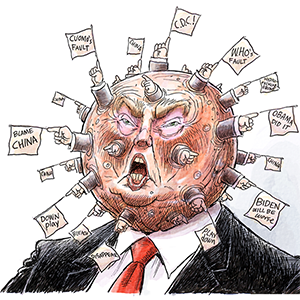US will ban cancer-linked Red Dye No. 3 in cereal and other foods
Published in News & Features
U.S. health officials banned the artificial food coloring Red No. 3, which has been linked to cancer and is currently in scores of products from candy to cold medicine.
The dye will no longer be allowed in U.S. food or ingested drugs starting Jan. 15, 2027, according to a Food and Drug Administration document posted online.
Red No. 3 is used in foods such as Brach’s candy corn from Ferrara Candy Co., Betty Crocker sprinkles from General Mills Inc. and strawberry Ensure from Abbott Laboratories. It is also found in drugs including Takeda Pharmaceutical Co. Ltd.’s Vyvanse for attention deficit hyperactivity disorder and store-brand heartburn pills from Costco Wholesale Corp. and Rite Aid Corp.
The move comes more than 30 years since the Food and Drug Administration prohibited the use of Red No. 3 in cosmetics after studies found tumors linked to the dye in lab rats. Consumer and patient advocacy groups petitioned the agency in 2022 to revoke the use of the food coloring in American diets.
The FDA said the dye doesn’t cause cancer in humans the same way it does in rats but under a provision known as the Delaney Clause, anything that causes cancer in humans or animals is not allowed in food in the U.S.
“The petitioners provided data demonstrating that this additive induces cancer in male rats,” the FDA wrote in its notice Wednesday. Bloomberg previously reported the decision.
One of the proponents of banning controversial dyes is Robert F. Kennedy Jr., President-elect Donald Trump’s nominee for secretary of the Department of Health and Human Services.
“If you can’t put it on your skin why would you eat it?” said Linda Birnbaum, former director of the National Institute of Environmental Health Sciences and the National Toxicology Program, in an interview last month. “Bright red dye is completely unessential. We don’t need bright red candies.”
Birnbaum signed the petition to ban Red No. 3 in the U.S. along with about 20 advocacy groups including Consumer Reports, Public Citizen and the Environmental Working Group.
The dye is common in U.S. supermarkets. About 26% of baking decorations and dessert toppings have the dye, according to an analysis of October data performed by healthy food app GoCoCo. It’s also found in 16% of chewing gum and mints, 13% of candy, and 11% of cookies and biscuits.
“Red Dye 3 poses an unacceptable risk to our health, especially when safer alternatives are readily available,” said Brian Ronholm, director of food policy at Consumer Reports. “By banning Red Dye 3, the FDA will protect the public by encouraging manufacturers to switch to safer ingredients already used in products sold in Europe and numerous other countries.”
The industry should be ready to remove Red No. 3, said Peter Lurie, executive director of Center for Science in the Public Interest, which also signed the petition, in an interview last month. California banned Red No. 3 in foods in 2023, though companies have until 2027 to make the change.
A spokesperson for General Mills said that the company will be in compliance with California’s law when it takes effect. Ferrara has already begun reformulating products without Red No. 3 to align with consumer preferences, a spokesperson told Bloomberg.
Shares of General Mills and Abbott were little changed on Wednesday in New York.
The Consumer Brands Association, a food industry group, and the National Confectioners Association, a candy-focused trade organization, both said companies would comply with the ban.
“Our consumers and everyone in the food industry want and expect a strong FDA, and a consistent, science-based national regulatory framework,” the candy group said in a statement. “FDA is the rightful national regulatory decision maker and leader in food safety.”
Red No. 3 is one of a handful of dyes that have recently come under scrutiny by state legislatures. Lawmakers are weighing bans on Red No. 40, which has been associated with hyperactivity in children, as well as Yellow Nos. 5 and 6, Blue Nos. 1 and 2, and Green No. 3.
“Red 3 has no place in our food, especially in food marketed to our kids,” said Scott Faber, senior vice president of government affairs at Environmental Working Group. “Now, the FDA needs to take the next step and ban other dangerous chemicals lurking in our food.”
Some food and drug makers have already begun switching to other types of dyes such as carmine, which comes from ground insects.
The only foods in the European Union that can use Red No. 3, known as erythrosin there, are cocktail and candied cherries.
The EU has a more robust system to review food additives than the U.S. does, Jim Jones, the FDA’s deputy commissioner for human foods, told U.S. senators during a hearing on industry tactics that have led millions of Americans to develop diabetes and obesity. Jones said the agency recently created an office to examine food chemicals that are on the market and is pushing Congress for more funding.
©2025 Bloomberg L.P. Visit bloomberg.com. Distributed by Tribune Content Agency, LLC.







Comments